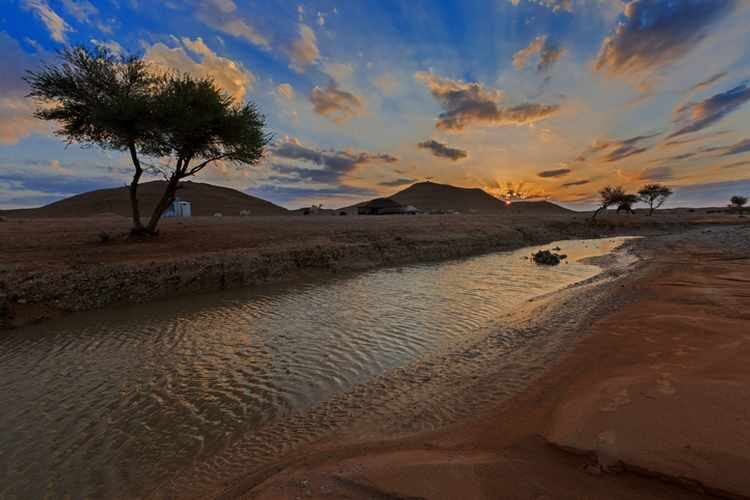The stone circles and structures, known as kites, have been found mainly in the Kingdom's western region. Aerial surveys found more nestled between the desert sands of the Great Nafud.
Believed to be Neolithic, the polygons, funnel, and triangle-looking structures are mainly concentrated near the Harrat Khaybar Lava fields in the west, some that date back to the fourth and seventh centuries B.C. The structures in Hail are found in Qaa Al-Sibaq near the town of Shuwaimis, northwest of Hail.
More than 5,800 desert kites have been discovered across Armenia, Saudi Arabia, Jordan, and Kazakhstan, with the highest concentration found in Syria with 2,500 kites.
Hidden treasures of the Kingdom's vast deserts remain unseen and are waiting to be discovered. Desert kites are sophisticated and well-engineered structures whose purpose remains a secret to this day.
Dr. Salma Hawsawi, a professor of ancient history at King Saud University, told Arab News that Saudi Arabia has an abundance of stone circles, kites, and structures scattered all over the Kingdom. Many desert kites were found in the area north of Madinah (Khaybar, Fadak, AlUla). The large slabs are in different shapes: Circles, triangles, ovals, raised stones, stone piles, squares, and arcs.
Hawsawi said the kites were geometric shapes that may be connected or unconnected to each other. They may be part of a building or separate, or stone piles: A group of stones on top of each other in a gradual form, not consistent in size or shape.
"Some of the triangles have small, large, and hollow bases, parallel and successive, opposite at the vertex," she said. "There are also circles with a middle point, hollow points, irregular, flat, and overlapping stones. Other shapes include circles with a square in the middle, small and large ovals, ovals overlapping with circles and squares, irregular squares, hollow and irregular rectangles, and rectangles stacked on top of each other."

- Believed to be Neolithic, the polygons, funnel, and triangle-looking structures are mainly concentrated near the Harrat Khaybar Lava fields in the west, some that date back to the fourth and seventh centuries B.C. The structures in Hail are found in Qaa Al-Sibaq near the town of Shuwaimis, northwest of Hail.
- More than 5,800 desert kites have been discovered across Armenia, Saudi Arabia, Jordan, and Kazakhstan, with the highest concentration found in Syria with 2,500 kites.
Hawsawi added: "In the same context, there are points in the middle of the circles or at their ends, points around the buildings and around the circle and the straight line, points in a zigzag or straight line, parallel, interconnected and separate arcs, in addition to unclear shapes."
Archaeological surveys conducted in 1976 found that these kites extend from the north of Wadi Sarhan to the Hail region. A year later, it was found that this area opened to the Al-Kahifiya suburb in the south. The spread of the kites showed the effect of the environment on the shape of the structure and the differences between one area to the next.
"The reason why these shapes are built in the way the area varies depends on the place where they were found. They could be trade routes, landmarks to guide caravans, or placed in certain areas as a place for worship, or to mark a residential area, or a burial place, or that it was used for hunting," she said.
Hawsawi pointed out that the concentration of these circles and kites around oases, water pools, and settlements, in Khaybar, Fadak, AlUla, up to Hail and Makkah, indicated that they were rest areas for trade caravans, especially since the Silk Road was linked to the north of the Arabian Peninsula through a secondary road from Persia.
After the road leaves Samarkand, it goes to Persia, then to Merv, a crossroads. The route then goes to Tifson, to Hit on the Euphrates River in Mesopotamia, and then heads to Palmyra, then to the coasts of the Mediterranean extending to Europe, according to Hawsawi.
"The reason why Silk Road merchants preferred to pass through the north of the Arabian Peninsula was the safety that the inhabitants of the north Arabian Peninsula provided for the trade convoys and that the land roads in the region were easier, better for transit, and safer for trade convoys," Hawsawi said.
She also pointed out that the southern road started from the port of Qena in Egypt then headed toward Shabwa, the capital of the Kingdom of Hadramout, from which the route extended through the capitals of the southern kingdoms Qataban, Sheba, and Main, all in modern-day Yemen.
The main commercial road reaches Najran, from which it branches into two sections, one of them towards north and northwest, along the coast of the Red Sea, passing through Tathleeth and Bisha. Then a branch of the road heads towards Makkah, while the main road continues to Yathrib (Madinah), then to Dedan and Lehyan until the first century B.C. The route then switches to Al-Hijr.
An American study, according to Hawsawi, found that the kites found in AlUla are older than the Pyramids of Giza and the stone circles of Stonehenge in the UK, which are more than 7,000 years old.
"These circles and kites reflect the extent of development reached by the ancient civilizations living in the Peninsula and how deeply rooted in history the lands that make up Saudi Arabia is today," Hawsawi said.





R.C.